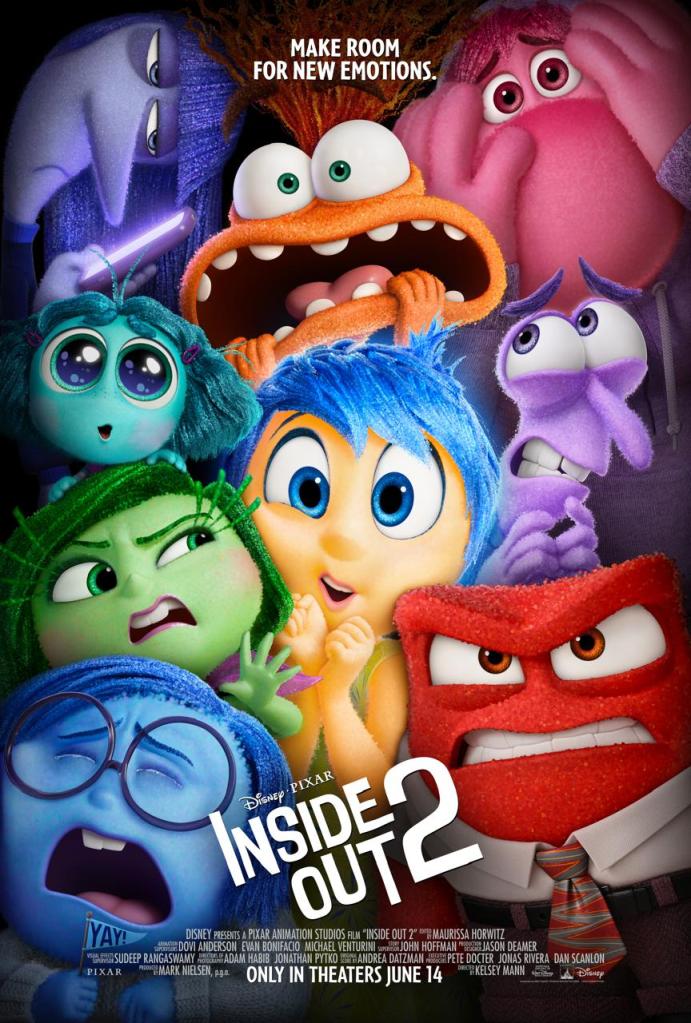Director Kelsey Mann carries forward the legacy of Pete Docter. However, the sequel is likely to resonate more deeply with adolescent girls and women.
Rating: ⭐️⭐️⭐️💫 (3.5 / 5)

By Mayur Lookhar
Nine years after blowing your mind by getting inside the human mind, Pixar Animation returns with Inside Out 2 (2024), the sequel to their Academy Award-winning Best Animated Feature.
During this nine-year wait, the protagonist has naturally grown, and there’s been a change in the voice cast, with Kensington Tallman replacing Kaitlyn Dias as the voice of Riley Anderson. Additionally, the director’s chair has seen a change, with Kelsey Mann succeeding Pete Docter. The story by Mann is penned by Meg LeFauve and Dave Holstein.
Inside Out [2015] is described as a coming-of-age animated film. The very idea of bringing human emotions to life is what makes Inside Out a path-breaking piece of cinema. It’s with the sequel, however, that both the film and the leading human character, Riley, truly come of age.
Joy, Sadness, Anger, Fear, and Disgust—the resident emotions living inside Riley’s mind—believe that the young girl is having a smooth life until a certain puberty button appears on the console. It’s at this point that Anxiety (voiced by Maya Hawke) creeps into Riley’s mind. Anxiety isn’t alone, as often with anxiety, there comes Envy (voiced by Ayo Edebiri), Ennui (voiced by Adèle Exarchopoulos), and Embarrassment (voiced by Paul Walter Hauser). Young Riley is consumed by her anxiety and is beginning to lose the joy in her life.
The Kelsey Mann directorial is a vibrant, entertaining allegory on a girl’s adolescent years. The subtle pubescent themes may be beyond the grasp of younger children, making Inside Out 2 more appealing to adolescents and adults. There is nothing inappropriate here; the film simply highlights the internal challenges young girls face during their formative years. The primary focus is on what’s happening in the mind of the 13-year-old girl. Regardless of gender, this is a phase where a teen is simply trying to find her voice. As toddlers, we have little understanding of emotions, and thus emotions and reflex actions govern the human mind and body, as seen in Inside Out (2015). Mann’s Inside Out 2 acknowledges the physiological changes and their mental impact, showing how humans strive to take control over their emotions rather than being controlled by them. It’s natural for anxiety to creep in, but the key is not to let it consume you. And that’s the message here.
The subtle pubescent theme also evokes memories of another coming-of-age Pixar film, Turning Red (2022), which focused more on physiology than the mind. While it’s nearly impossible to replicate the joy of Inside Out (2015), Mann’s film is nonetheless highly entertaining. Pixar continues to amaze by creating numerous magical worlds within the human brain. They elevate their visual storytelling, though the engagement levels have their ebb and flow.
Apart from Riley, there are certain changes in the voice cast as well. Tom Hale does well as the voice of Fear, though Bill Hader is missed in this role. Mindy Kaling is also missed, with Liza Lapira taking over as the voice of Disgust. Phyllis Smith delivers a more understated performance as Sadness, while fans yearn for more rage from Lewis Black. Nevertheless, he remains the most humorous character.

Maya Hawke shines in her portrayal of Anxiety, fully embodying the character’s overly anxious avatar. The character design itself exudes anxiety, with bulging eyes and a chameleon-like face that could make Anxiety resemble a distant cousin of the equally anxious Randall from Monster Inc (2001). Hawke brings Anxiety to life in her unique and compelling style.

Among the new emotions, the most innocent and likable is Embarrassment. Although it doesn’t speak, its character design and constant embarrassed expression make it an endearing character to watch. Then we see this little Pouchy [voiced by James Austin Johnson], who bails Joy & co out of tricky situations.

Riley, or any human, what would life be without joy? That’s the greatest compliment one can pay to Amy Poehler, who, as the voice of Joy, is the heart and soul of this franchise. Poehler’s tone brings joy to Riley and viewers. If there ever was something as the ‘mother of all emotions,’ then that would be Joy
Like we said before, it’s difficult to compare the two films as they run through the same gamut of emotions. The stark difference in Inside Out 2, though, is how this one is likely to resonate more with adolescent girls and women. The sound of two women blowing their noses indoors, choked with emotion, on either side of this writer, reminds us why it takes a woman to best understand a girl. Take a bow to the complexities of a woman’s mind. What’s that Bryan Adams song, ‘I Wanna Know You Inside Out’? Go unravel Riley’s beautiful mind in Inside Out 2.